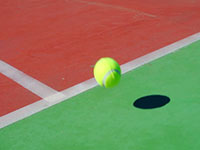FREQUENTLY ASKED QUESTIONS ABOUT TENNIS RULES AND MEMRLTA BY-LAWS
 Go to our print-friendly page to print these FAQs.
Go to our print-friendly page to print these FAQs.

Q: If, during play, the ball is out, however the opposition play on then we play on and win the point are they allowed to now say that the shot 2 hits before was out and claim the point?
A: According to Tennis Australia's "Tennis Etiquette and Rules for Non-Umpired Matches":
"Any 'out', 'let' or 'fault' call must be made immediately (ie made before either an opponent has hit the return or the return has gone out of play); otherwise the ball continues in play. 'Calls' must be verbal and clearly audible to the opponent, followed by a signal if necessary. 'Lets' may be called by any of the participating players."
So, to specifically answer this question, if the opponents had not called the ball out before you hit their return, the ball is considered to still be in play. Your opponents are NOT allowed to now say that the shot 2 hits before was out and claim the point.
Q: If, in the middle of a game, it is discovered that players on the receiving team have swapped sides (ie, the player who had, in the first game when her side was receiving, played on the forehand side and had thus received first was now playing on the backhand side and receiving second, and vice versa), when should the players swap back to their correct positions?
A: According to the International Tennis Federation's 2020 Rules of Tennis" rule 27(e): "During a standard game or a tie-break game in doubles, if there is an error in the order of receiving, this shall remain as altered until the end of the game in which the error is discovered. For the next game in which they are the receivers in that set, the partners shall then resume the original order of receiving."
The Rules also state that "as a principle, when an error in respect of the Rules of Tennis is discovered, all points previously played shall stand."
Q: During a game of doubles, it is discovered that a partner served out of turn. What happens if it is discovered after a:
(1) first service fault?
(2) point has been played?
(3) game is complete?
A: (1) & (2): The partner who ought to have served shall serve as soon as the mistake is discovered, but all points scored and any fault served before such discovery shall be reckoned.
(3): The order of service remains as altered. (ITF rule 27c)
Q: On a hot day at what stage is the match deemed a "heatout"?
A: When the temperature at the weather bureau reaches 32 degrees, play may be stopped at the option of either captain. If all players wish to continue, however, they may do so. (MEMRLTA by-law 12f)
Comment from Records Secretary: On days of heatouts/washouts, ensure that all games played—even those of incomplete sets—are recorded on the scorecard and in Match Centre. These games are included in the calculation of each team's percentage.
Q: If a player has a pre-existing injury or medical condition, is she allowed to take the court?
A: Yes, so long as the player honestly believes she will be able to play the three full sets, she may take the court. Planned substitutes are not allowed.
Q: Can a player reach over the net to hit a ball?
A: Only in certain circumstances. A player loses the point if she hits the ball before it has passed the net. A player's racquet may pass over the net after hitting the ball on her own side of the net. Also, if the ball in play has hit the ground and then spun or been blown back over the net, the player may reach over the net to hit the ball.
In any circumstance, a player loses the point if she or her racquet or anything she is wearing or carrying touches the net while the ball is in play.
The formula for calculating a team's percentage is:
(sum of the number of games won in each round)
divided by
(sum of the number of games lost in each round)
For example, if a team's scores for its first three matches of a season are:
45-34
15-19 (washout)
39-35
then the team's percentage after Round 3 is:
(45 + 15 + 39) / (34 + 19 + 35) = 99/88 = 1.125 = 112.50%
Q: If players cannot agree on the score, what should they do?
A: According to Tennis Australia's "Rules for Non-Umpired Matches" rule (f):
"If players cannot agree on the score, they should calmly discuss the points/games that are the areas of disagreement. If they cannot reach agreement they should replay only the points or games in question. All points or games which the players agree on stand.
For example, two teams cannot agree on whether the score is 40-15 or 30-30, but agree on the winner of the first, second and fourth points. Therefore only the third point needs to be replayed."

Q: Can I call a foot fault on my opponent, and what exactly is a foot fault?
A: Foot faults can be called only by a line/foot fault umpire which MEMRLTA matches do not have. So it is the responsibility of all players to ensure that through their service action, foot faulting does not occur.
The 2020 ITF Rules of Tennis, Rule 18 – Foot Fault states:
During the service motion, the server shall not:
- Change position by walking or running, although slight movements of the feet are permitted, or
- Touch the baseline or the court with either foot, or
- Touch the area outside the imaginary extension of the sideline with either foot, or
- Touch the imaginary extension of the centre mark with either foot.
If the server breaks this rule, it is a "Foot Fault".
Note that the service motion is completed at the moment that the player’s racket hits or misses the ball (ITF Rule 16).
Q: If the first serve is a fault but then a ball from another court rolls onto your court interrupting the second serve, does the server resume the second serve or start again with a first serve once the wayward ball has been removed?
A: Whenever a ball from another court interrupts play, the whole point is started over. In this case the server is entitled to another first serve. (ITF rule 23)
Q: When serving, may the server position herself in the centre of the baseline with one foot on either side of the centre line?
A: No. When serving, the server shall stand at rest with both feet behind (ie, further from the net than) the baseline and within the imaginary extensions of the centre mark and the sideline. (ITF rule 16) When serving in a standard game, the server shall stand behind alternate halves of the court, starting from the right half of the court in every game. The service shall pass over the net and hit the service court diagonally opposite, before the receiver returns it. (ITF rule 17)
Q: The week before the match, I phoned the captain of the team we were going to play to say that our team would be unable to arrive at their courts until just before 10am so we would prefer a 10:00 start. The other captain insisted on a 9:30 start and said that in the MEMRLTA fixture book the starting time for matches at their courts is listed as 9:30. Can they insist on a 9:30 start?
A: No. The official MEMRLTA starting time is 10am. By mutual agreement, however, matches may commence at a different time. In practice, most MEMRLTA matches begin at 9:30 but this is by mutual agreement and no club can unilaterally decide that a match must commence at 9:30 or any other time other than the official 10am start time. Starting times listed in the MEMRLTA fixture for each team are simply preferred starting times for their home matches not official starting times. If two clubs cannot agree on a starting time, then they have to accept the official 10am start. See MEMRLTA by-law 9a(i).
MEMRLTA is affiliated with Tennis Victoria, part of Tennis Australia. Please refer to the Tennis Australia website for a list of approved tennis balls.

Q: How much time are you allowed between points?
A: Guidelines from Tennis Australia’s "Rules for Matches Without a Chair Umpire" state: The receiver must play to the reasonable pace of the server. All players must ensure they restrict their warm up time, and minimise time between points and at change of ends.


